August 4 / Arrive Reykjavik
Meet by a representative of Aurora Expeditions and transferred to group hotel. Upon arrival at your included hotel, please visit the Aurora Expeditions hospitality desk to collect your luggage cabin tags and to speak with the ground operations team, who may have information to share with you about pre-embarkation or to provide you with information about where to dine, withdraw cash or purchase last minute items from a local pharmacy or supermarket.
The remainder of your time is at leisure. All meals today are at your own expense.
Accommodation: The Grand Hotel Reykjavik (or similar)



Airport transfer
August 5 / Embarkation day
Breakfast and check-out. Join a guided tour of Golden Circle and Geothermal Energy. With 85% of it’s electricity sourced from renewable sources, Iceland sets an outstanding example when it comes to sustainable energy.
The tour visits the famous seismic sights of the Golden Circle route - Gullfoss waterfall, Geysir, and history-rich Thingvellir National Park. Next, experience first-hand how green, sustainable energy is produced at one of the largest geothermal power plants on the planet at the Geothermal Energy Exhibition and Ljósafossvirkjun Power Station.
End the tour at a true eco-village, Sólheimar. Powered with thermal and solar energy its fully sustainable, boasting greenhouses, forestry programmes, and workshops on candle-making, carpentry, weaving and soap-making.
Late afternoon return to Reykjavik for embarkation. This evening, get to know your fellow expeditioners, expedition team and crew.

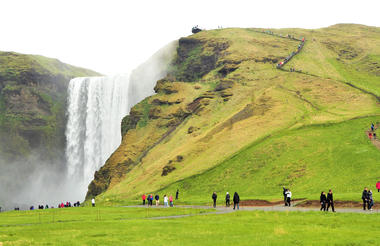
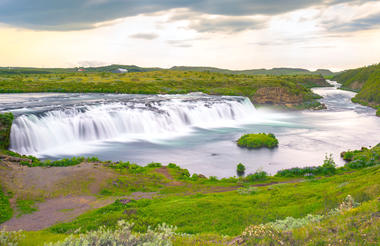
Breakfast
Tour of Golden Circle route
August 6 / At Sea
Crossing the Greenland Sea, sail through the Polar Basin’s nutrient-rich waters, searching for encroaching pack ice, fin whales and seabirds. The team of experts entertains with informative talks about sea ice, glaciers, European arctic plants and animals and epic tales of early explorers such as Nansen, Andreé and Scoresby.



August 7 / Kangertitivatsiaq Fjord
Popular among skilled rock climbers, Kangertitivatsiaq Fjord is home to spectacular mountain peaks and essential big walls that attract daring climbers. A new discovery for Aurora Expeditions in 2022, the 26-kilometre (16-mile) fjord is filled with glaciers including the Glacier of France. It’s an ideal place for ship cruising, Zodiac excursions and discovery hikes.



August 8 / Skjoldungen Island
Continue south along Greenland’s King Frederik VI Coast, always on the lookout for whales, especially the rare sperm whale that is occasionally seen here. Weaving through the narrow channels of Skjoldungen Fjord land at the end of the fjord for a walk along a glacial river, across a tundra valley covered in northern willow and blooming pink wildflowers. Kayakers can paddle across the front of a tidewater glacier, search for harp seals, ivory gulls and whales.
Back on board, enjoy the stunning surrounds with a drink in hand basked in the soft light of the setting sun.
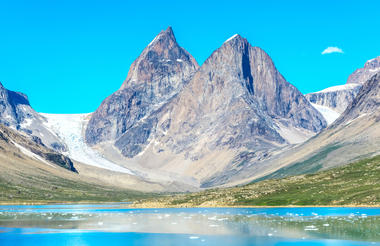
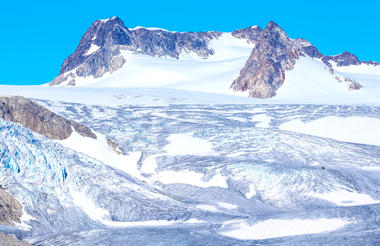
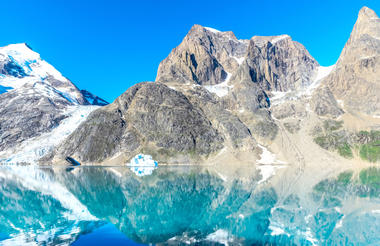
August 9 / Prince Christian Sound
Prince Christian Sound connects the Labrador Sea with the Irminger Sea. Approximately 100 km / 60 mi long, and, in parts, as narrow as 500-m (600-ft) wide, the fjord is flanked by jagged mountain peaks, some reaching over
2,200 m (7,200 ft) high, with countless glaciers coming all the way down to the sea. We slow-cruise through the sound to enjoy the spectacular scenery. Icebergs sculpted into fantastic shapes often block the entrance to the sound, a great spectacle for photography.
August 10 / Aappilattoq, Tasermiut Fjrd, Klosterdal
Aappilattoq is a small settlement that lies in the southern section of a sound. Aappilattoq means red in Greenlandic, and the town is named after the red mountains rising above it. The jagged mountain peaks are a delight for photographers.
The towering, jagged mountains that surround Tasermiut Fjord is why it’s often referred to as the ‘Patagonia of the north’. At Klosterdal, we are surrounded by three giant mountains - Napasorsuaq, Ketil and Nalumasortoq. Here walk to a Norse ruin, hike along the valley, or explore the bay by kayak.
August 11 / Nanortalik, Uunartoq
Continue to Nanortalik, the southernmost town in Greenland. Its name derives from the West Greenlandic word ‘Nanoq’ meaning ‘the place where bears pass through. Deep fjords, woodlands and grasslands, and rugged mountainside cliffs, some over 1,000 m /3,280 ft, attract enthusiastic climbers from around the world.
On arrival, you’ll receive a warm welcome from the local community who have opened up their town for you to explore. Nanortalik is a town that’s known for their love of singing and you’ll be treated to choir performance.
Visit Nanortalik Church, a wooden, Danish Lutheran church built in 1916 and is currently the only church serving the Nanortalik congregation. The church is in the old colonial quarter of the town. Next to the church is a landmark boulder called the ‘Knud Rasmussen Stone,’ named after Greenland’s most famous citizen, Dr Knud Rasmussen, an explorer and ethnologist.
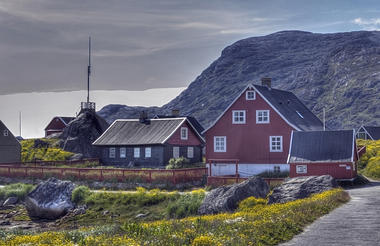
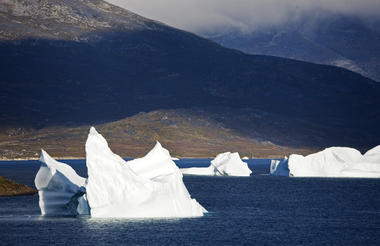
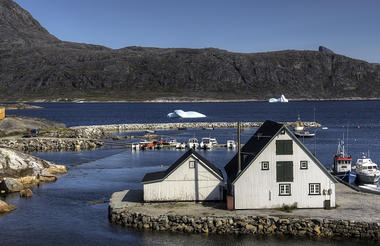
August 12 / Hvalsey, Qaqortoq
Hvalsey Church is the best-preserved Norse ruin in Greenland built in early 14th century. ‘Hvalsey’ is old Norse for ‘Whale Island.’ Christianity arrived in Greenland around 1,000 AD and gradually churches began to be built. Late medieval documents indicate there were up to 14 parish churches in the Eastern Settlement.
After exploring Hvalsey ruins, continue to Qaqortoq, where our Zodiacs shuttle us ashore. Qaqortoq is the capital of South Greenland. With a history dating back to 1775, the town offers various cultural activities and attractions. We will visit the administrative centre, the Qaqortoq Museum and the Church of our Saviour.



August 13 / Igaliku
At Igaliku in Tunulliarfik Fjord, lush valleys filled with tall grass hints at Greenland’s first sheep farming settlement. Igaliku also guards the entrance to the well-preserved remains of Norse ruins allowing visitors to explore Norse history, hike within the UNESCO World Heritage-listed surroundings to discover lakes, mountains and hidden Norse ruins.
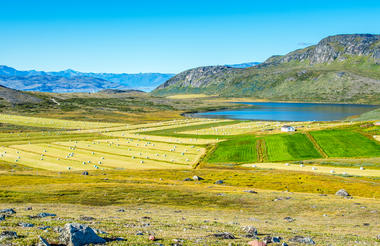

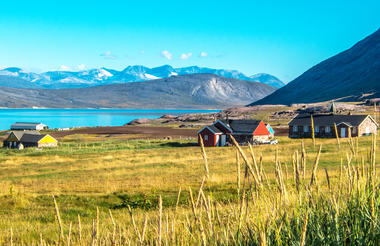
August 14 / Narsarsuaq, Qassiarssuk
Narsarsuaq is the gateway to hiking trails through lush valleys and Norse ruins spotted along Tunulliarfik Fjord.
Narsarsuaq holds historical significance to Greenland’s history. The Norse Vikings settled in this area in the 12th century. Taking home stories of lush valleys and plains nestled in deep fjord, the Vikings called this country Greenland.
Marked trails allow hikers to enjoy the superb scenery, with the one of the most popular hikes leading to the spectacular lookout over icebergs in the Tunulliarfik Fjord and the Qooroq Glacier.
At Qassiarssuk, located directly across the Tunulliarfik Fjord, follow in the footsteps of Erik the Red and discover why he made it his home. The remains of a church, stables, hall and other buildings can still be seen. Visit the tall statue of Leif Erikson (son of Erik the Red) overlooking the town and fjord.
Sailing between Hvalsey, Igaliku and Qassiarssuk allows you to connect the dots of Viking history in Greenland.
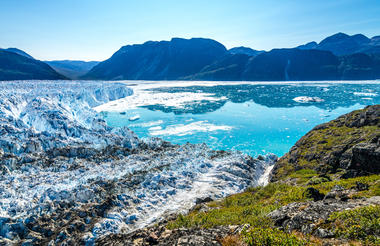

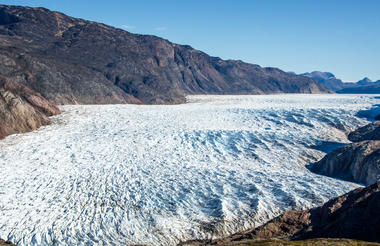
August 15 / At Sea
Sail towards Nuuk, enjoy some free time relaxing or attending a presentation from the expedition team. This evening, share stories and celebrate with fellow expeditioners at Captain’s Farewell Dinner.
August 16 / Disembark in Nuuk, Fly to Toronto
Disembark in Nuuk, Greenland's capital, where you farewell the crew and expedition team before transferring to the airport for our charter flight to Toronto.
Accommodation: Westin Toronto Airport Hotel (or similar)
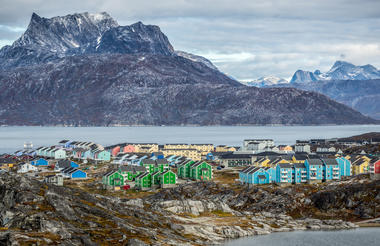
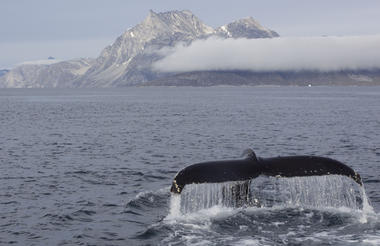
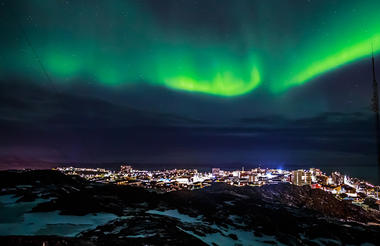
Charter Flight
Transfer to Toronto hotel
August 17 / Depart Toronto
After breakfast, check out of your room and continue your journey with a transfer to the airport.
Airport Transfer




